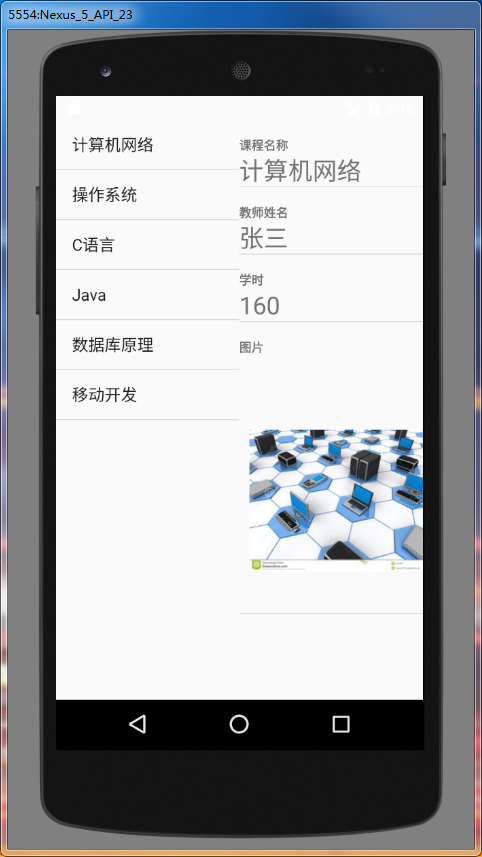ListFragment繼承了Fragment,顧名思義,ListFragment是一種特殊的Fragment,它包含了一個ListView,在ListView裡面顯示數據。 1. MainActivity Java類文件: xml佈局文件: 可見MainActivity是比較簡單的,在佈局裡面放了 ...
ListFragment繼承了Fragment,顧名思義,ListFragment是一種特殊的Fragment,它包含了一個ListView,在ListView裡面顯示數據。
1. MainActivity
Java類文件:
package com.example.hzhi.fragmentdemo; import android.app.Activity; import android.os.Bundle; import android.app.FragmentManager; import android.app.FragmentTransaction; public class MainActivity extends Activity { private FragmentManager manager; private FragmentTransaction transaction; @Override protected void onCreate(Bundle savedInstanceState) { super.onCreate(savedInstanceState); setContentView(R.layout.activity_main); manager = getFragmentManager(); transaction = manager.beginTransaction(); ListFragmentImpl frgImpl = new ListFragmentImpl(); ListFragmentSelf frgSelf = new ListFragmentSelf(); transaction.add(R.id.fragment1, frgImpl, "frgImpl"); transaction.add(R.id.fragment2, frgSelf, "frgSelf"); transaction.commit(); } }
xml佈局文件:
<LinearLayout xmlns:android="http://schemas.android.com/apk/res/android" xmlns:tools="http://schemas.android.com/tools" android:layout_width="match_parent" android:layout_height="match_parent" android:orientation="horizontal" > <LinearLayout android:id="@+id/fragment1" android:layout_weight="1" android:layout_width="match_parent" android:layout_height="match_parent" android:orientation="vertical"/> <LinearLayout android:id="@+id/fragment2" android:layout_weight="1" android:layout_width="match_parent" android:layout_height="match_parent" android:orientation="vertical"/> </LinearLayout>
可見MainActivity是比較簡單的,在佈局裡面放了左右兩個ListFragment。
2. ListFragment
2.1 左邊的ListFragment
Java類文件:
package com.example.hzhi.fragmentdemo; import android.app.ListFragment; import android.widget.ListView; import android.os.Bundle; import android.view.LayoutInflater; import android.view.View; import android.view.ViewGroup; import android.widget.ArrayAdapter; import android.util.Log; import android.widget.Toast; import android.widget.SimpleAdapter; import java.util.Map; import java.util.HashMap; import java.util.List; import java.util.ArrayList; public class ListFragmentImpl extends ListFragment{ private static final String TAG = "ListFragmentImpl"; private ListView selfList; String[] classes = { "電腦網路", "操作系統", "C語言", "Java", "資料庫原理", "移動開發", }; @Override public View onCreateView(LayoutInflater inflater, ViewGroup container, Bundle savedInstanceState) { Log.d(TAG, "onCreateView"); return inflater.inflate(R.layout.list_fragment_impl, container, false); } @Override public void onCreate(Bundle savedInstanceState) { Log.d(TAG, "onCreate"); super.onCreate(savedInstanceState); // 設置ListFragment預設的ListView,即@id/android:list this.setListAdapter(new ArrayAdapter<String>(getActivity(), android.R.layout.simple_list_item_1, classes)); } public void onListItemClick(ListView parent, View v, int position, long id) { Log.d(TAG, "onListItemClick"); // 找到ListFragmentSelf ListFragmentSelf listFragmentSelf = (ListFragmentSelf) getFragmentManager(). findFragmentByTag("frgSelf"); listFragmentSelf.flushData(position); } }
佈局文件:
<?xml version="1.0" encoding="utf-8"?> <LinearLayout xmlns:android="http://schemas.android.com/apk/res/android" android:layout_width="match_parent" android:layout_height="match_parent" android:orientation="vertical" > <!-- ListFragment對應的android:id值固定為"@id/android:list" --> <ListView android:id="@id/android:list" android:layout_width="match_parent" android:layout_height="match_parent" android:drawSelectorOnTop="false" /> </LinearLayout>
2.2 右邊的ListFragment
Java類文件:
package com.example.hzhi.fragmentdemo; import android.app.ListFragment; import android.widget.ListView; import android.os.Bundle; import android.view.LayoutInflater; import android.view.View; import android.view.ViewGroup; import android.util.Log; import android.widget.SimpleAdapter; import java.util.Map; import java.util.HashMap; import java.util.List; import java.util.ArrayList; public class ListFragmentSelf extends ListFragment{ private static final String TAG = "ListFragmentImpl"; private ListView selfList; final String[] from = new String[] {"name", "title", "info", "picture"}; final int[] to = new int[] {R.id.text0, R.id.text1, R.id.text2, R.id.picture}; private String[] tname = new String[]{"電腦網路", "操作系統", "C語言", "Java", "資料庫原理", "移動開發"}; private String[] ttitle = new String[]{"張三", "李四", "王五", "Tom", "Mike", "Peter"}; private String[] ttime = new String[]{"160", "50", "40", "200", "180", "150"}; private int[] pic = new int[]{R.drawable.jsjwl, R.drawable.czxt, R.drawable.cyy, R.drawable.java, R.drawable.sjkyl, R.drawable.ydkf}; @Override public View onCreateView(LayoutInflater inflater, ViewGroup container, Bundle savedInstanceState) { Log.d(TAG, "onCreateView"); return inflater.inflate(R.layout.list_fragment_self, container, false); } @Override public void onCreate(Bundle savedInstanceState) { Log.d(TAG, "onCreate"); super.onCreate(savedInstanceState); flushData(0); } public void onListItemClick(ListView parent, View v, int position, long id) { Log.d(TAG, "onListItemClick"); } public void flushData(int p){ // 建立SimpleAdapter,將from和to對應起來 SimpleAdapter adapter = new SimpleAdapter( this.getActivity(), getSimpleData(p), R.layout.list_item, from, to); this.setListAdapter(adapter); } private List<Map<String, Object>> getSimpleData(int p) { List<Map<String, Object>> list = new ArrayList<Map<String, Object>>(); Map<String, Object> map = new HashMap<String, Object>(); map.put("title", "課程名稱"); map.put("info", tname[p]); list.add(map); map = new HashMap<String, Object>(); map.put("title", "教師姓名"); map.put("info", ttitle[p]); list.add(map); map = new HashMap<String, Object>(); map.put("title", "學時"); map.put("info", ttime[p]); list.add(map); map = new HashMap<String, Object>(); map.put("title", "圖片"); map.put("picture", pic[p]); list.add(map); return list; } }
佈局文件:
<?xml version="1.0" encoding="utf-8"?> <LinearLayout xmlns:android="http://schemas.android.com/apk/res/android" android:layout_width="match_parent" android:layout_height="match_parent" android:orientation="vertical" > <!-- ListFragment對應的android:id值固定為"@id/android:list" --> <ListView android:id="@id/android:list" android:layout_width="match_parent" android:layout_height="match_parent" android:drawSelectorOnTop="false" /> </LinearLayout>
行佈局文件:
<?xml version="1.0" encoding="utf-8"?> <LinearLayout xmlns:android="http://schemas.android.com/apk/res/android" android:layout_width="match_parent" android:layout_height="match_parent" android:orientation="vertical" > <TextView android:id="@+id/text0" android:textSize="12sp" android:textStyle="bold" android:layout_width="match_parent" android:layout_height="wrap_content"/> <TextView android:id="@+id/text1" android:textSize="12sp" android:textStyle="bold" android:layout_width="match_parent" android:layout_height="wrap_content"/> <TextView android:id="@+id/text2" android:textSize="24sp" android:layout_width="match_parent" android:layout_height="wrap_content"/> <ImageView android:id="@+id/picture" android:layout_width="wrap_content" android:layout_height="wrap_content" android:paddingLeft="10dp" /> </LinearLayout>
最重要的方法是,當點擊左邊ListFragment的某一行時,取得改行的position,然後根據Tag找到右邊的ListFragment,並調用flushData()方法,使右邊的ListFragment刷新數據。
3. 運行結果




